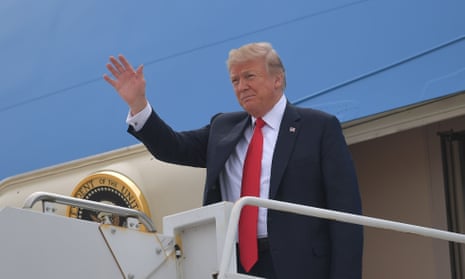Donald Trump’s past visits to California have been marked by chaotic protests, violent clashes and arrests.
But his return this week may be different. That’s because no one knows where he’s going.
Trump’s planned trip to the liberal Bay Area on Tuesday – his first as president – has been shrouded in secrecy, with officials declining to reveal the city where he’s holding a high-priced fundraiser. The visit to California, his fourth time traveling to the state since taking office, comes as the political and legal battles between the Trump administration and Democrats in California are dramatically escalating.
The president, who has recently criticized California’s cities over the growing homelessness crisis, is expected to raise millions at a lunch somewhere in the Bay Area on Tuesday, followed by visits to Los Angeles and San Diego. Initial rumors suggested he would be going to Atherton, a Silicon Valley suburb in the country’s wealthiest zip code, but city officials there said it appeared plans had changed.
Trump’s visit is a reminder that even though California remains a reliable Democratic stronghold and is seen as the leader of the “resistance” to the president’s agenda, there are pockets that vote Republican and continue to back the president. And some of them are opening their wallets.
“He’s coming here because he wants money,” said Jessica Levinson, a Loyola law school professor. “California is the nation’s ATM. There’s a lot of wealth here. It’s smart fundraising.”
Harmeet Dhillon, a Republican National Committee member from San Francisco and co-host of the Bay Area fundraiser, declined to share the location and other details with the Guardian, but said several hundred would be attending, some donating as much as $100,000.
“I hope he sees that there are many Californians who are strongly supporting what he’s doing nationally,” she said.
In California, which has formally sued the Trump administration dozens of times, residents have donated more money to the Trump 2020 campaign than to most Democratic candidates, according to an analysis in July. At the time, Trump had raised $3.2m in California, which was more than Joe Biden and Bernie Sanders had received from Golden State supporters.
Intense backlash and calls for boycotts are expected when information does emerge about the California donors supporting Trump this time around. Some northern California anti-Trump groups have been organizing protest efforts, though they have struggled to make specific plans given the unknown location, the East Bay Times reported.
Dhillon said she and others were not disclosing details because of safety concerns surrounding the potential for “violent protesters”. She said she feared local police would not properly protect Trump’s guests.
Trump’s previous trip to the region was a June 2016 San Jose rally, which saw physical confrontations between demonstrators and Trump fans.
In recent years, pro-Trump rallies and far-right events in the state have repeatedly devolved into violence, but police and prosecutors have repeatedly targeted leftwing activists for arrest and prosecution even when they were victims of attacks.
Last week, the Trump administration also sparked fears in Los Angeles with a visit to the city’s Skid Row, the epicenter of the homeless crisis, which came amid rumors that the president was seeking to push some kind of crackdown on people living on the street. There are growing concerns that the administration could try to relocate people out of encampments, and some reports have suggested Ben Carson, Trump’s housing and urban development secretary, will be visiting Los Angeles this week.
The administration also secretly toured an abandoned Federal Aviation Administration facility in the region as a potential place to move people, according to the Washington Post.
“We have a humanitarian crisis,” said Levinson. “[Trump] rightly knows that it makes California and Los Angeles look terrible. The goal is bad publicity for Democrats.”
Local advocates for homeless people told the Guardian last week they would welcome federal funding for housing and other social services, which the Trump administration has cut. But they said they were concerned about efforts to forcibly remove people or further criminalize the homeless – whether by the US government or local authorities.
“You’re the US government. Treat it like a state of emergency,” said Stephen “Cue” Jn-Marie, a Los Angeles pastor who works with Skid Row residents. “Give us resources we need to build housing.”
It’s unclear if the president would have any legal authority relating to the placement of homeless people on the streets, an issue which is typically handled by municipal governments.
Dhillon, of the RNC, said she was grateful he was talking about the subject. But she said: “What can the president do about it? That’s an open question. This is really a quintessentially local issue.”
